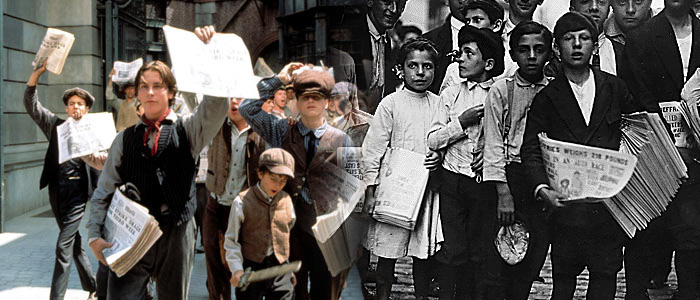Newsies: the real story compared with the Movie/Musical

Newsies, the movie from Walt Disney Studios, was a significant influence in the writing of Calling Extra. I was ten years old when the film premiered in theaters, and I replayed my VHS so much that it wore the tape down and distorted the audio of the musical numbers.
My profound interest in the actual event that occurred in the summer of 1899 fueled the need to know more. In doing so, I’ve spent years of research in the time period to understand better the world the newsies lived in, why they striked, and how they won (if you would even consider it a “win” at all).
The major differences between the movie and the actual events have much to do with the basis of Hollywood movie-making, and I don’t fault the screenwriters or producers in their modification.
Below are a few false portrayals of the history and some clarification:
1. Jack Kelly was not the leader of the strike – and falsely, as other websites and books report, Kid Blink wasn’t either. There was a “Jack” Sullivan in one newspaper as someone who spoke before the crowd and ignited the newsies to strike. But reporting of him stops there. Kid Blink, an Irish newsboy of fifteen who was blind in one eye, is peppered throughout the papers with rousing speeches. There’s no description that he wore an eye patch, despite how he is portrayed in my novel and Newsies.
The real leaders of the strike? The boys elected a Newsboy Strike Committee that consisted of Kid Blink (sometimes referred to as a “Blind Diamond”) as the chief organizer, Dave Simmons (a boy “prize-fighter”) as the president, Little Mikey – orator, Jim Gaiety, Young Monix, Barney Peanuts, Crutch Morris, Crazy Arborn (who I later discovered was not a newsboy at all but sold pretzels), Scabutch or Scabooch, and Abe Newman.
However, the Strike Committee was restructured after Dave and Kid were voted out for allegedly betraying the newsboys. This included electing a grown-up as the President and Racetrack Higgins as the Vice-President.
Interestingly, Racetrack Higgins was the real “voice of Brooklyn” and not Spot Conlon, as portrayed in Newsies. Although Spot Conlon is mentioned once in the papers as the “Grand Master Workboy of Brooklyn,” Racetrack is throughout all the papers and had a major influence on the strike.
2. The Newsboys didn’t officially win but compromised. It was a great accomplishment to halt the distribution of New York’s most popular papers for two weeks. But the newsboys got very restless as the Newsboy Union’s Strike Committee turned down offers from Pulitzer and Hearst throughout the two weeks. These offers included 55 cents a hundred, compared with the boys’ demand for 50 cents a hundred (reduced from the contested 60 cents a hundred—the reason they were striking).
After two weeks, Pulitzer and Hearst spoke through their circulation managers to the newsboys, and not the Union Committee, a compromise of offering the boys 100% return rights (they could return the unsold papers for a refund). The newsboys jumped on it – much to the disagreement of the Newsboy Union’s Strike Committee. The official decision makers of the Union committee did not agree to the compromise and said they would continue to strike. The newsboys, however, went back to work anyway.
3. The newsboys were not unique in their decision to strike and did not strike immediately after a price hike. The newspapers for the summer of 1899 are full of strikes, from the surface railroad “trolley” strikers of Brooklyn to the messenger boys of Manhattan. Strike fever was everywhere. The Spanish-American war, which had driven the price of the papers up to 60 cents a hundred on the newsboys, ended in April, and the boys struck in June. That’s two months of the boys feeling the pinch of the price hike. They were selling a lot of papers and “extra” editions during the war, which justified the price hike since the papers were printing more editions. However, when the war ended, all the other papers reduced their prices back to previous costs before the war except Pulitzer’s Evening World and Hearst’s Evening Journal.
Although many women and men sold newspapers, newsboys (including those who went to school during the day) preferred selling these evening papers and were taking a loss.